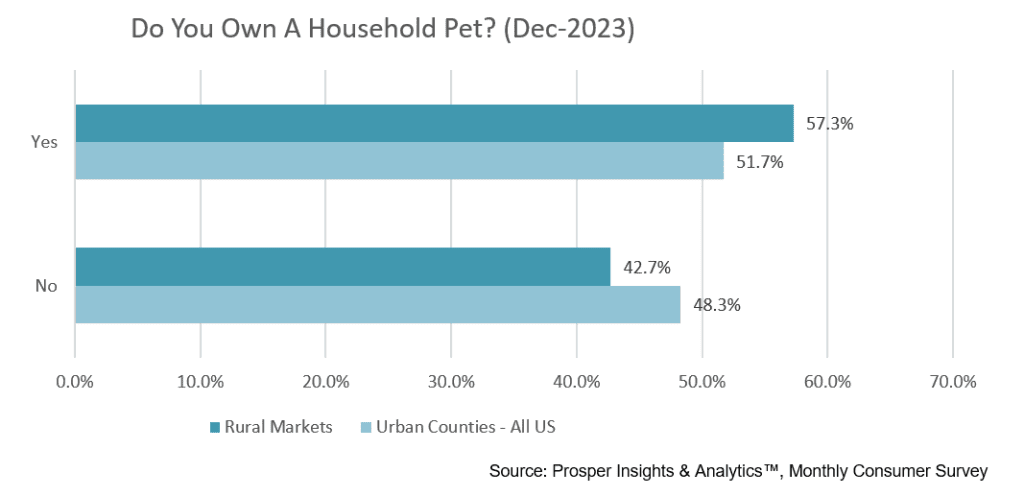

Americans love their pets, prioritizing supplies and care even as prices rise, presenting a pet retail marketing opportunity to acquire new customers.
Did you know?
Pet care sales rose more than 11% in the past year, despite inflation and rising prices that have affected disposable income for many consumers.1
- 70% of U.S. households have at least one pet. Specifically, 54% of households own dogs and 35% own cats.2
- Consumers in rural markets are 5% more likely to own a household pet than consumers in urban counties.3


Spending on pet supplies and care is on the rise, a trend that is expected to continue through 2023. By 2025, pet owners are expected to spend roughly $1,320 per pet annually, and that number could reach $1,897 by 2030, according to a national survey of pet owners by the American Pet Products Association (APPA).1
Millennials make up the largest percentage of current pet owners, followed by boomers4:
- Millennials, 32%
- Boomers, 27%
- Gen X, 24%
- Gen Z, 14%
Millennials and Gen Z are more likely to have acquired a new pet during the pandemic and subsequently spent more on those pets. These age groups are more likely to purchase all categories of supplies online, as well as to obtain pet supplies through an online subscription. In addition, they are more likely to try a larger variety of pet products.
Baby boomers and Gen X are more likely to see the benefits of pet ownership, such as social and emotional benefits. They consistently spend more for pet care, like food and vet visits.4
Connect with Consumers of All Ages with Messaging Valued Across Generations
Direct mail and email have a high perceived value across generations, from Gen Z to Boomers.5 A pet retail marketing strategy with a coordinated mix of both can increase reach and response.




Communicate Value to Consumers Experiencing Rising Pet Care Costs
Due to supply chain shortages in the pet products industry along with consecutive years of rising inflation, pet care products have increased in cost. This has affected consumers’ purchasing habits, as they either choose to pay more for the goods or switch to less expensive options.6
Pet Product News reported that pet owners prioritize quality, value, and convenience when planning their pet purchases:7 Does your pet retail marketing strategy focus on these priorities?
- Quality, 79%
- Affordability, 56%
- Shopping/buying convenience, 49%
From urban counties to rural markets, discount stores are the most popular choice for making pet purchases, but with a significant number choosing “no preference” and “other,” there is opportunity to acquire new customers for your pet supplies business.3


Spending on pet supplies and care is on the rise, a trend that is expected to continue through 2023. By 2025, pet owners are expected to spend roughly $1,320 per pet annually, and that number could reach $1,897 by 2030, according to a national survey of pet owners by the American Pet Products Association (APPA).1
Across generations, millennials are the most likely age group to own a pet:4
Millennials make up the largest percentage of current pet owners, followed by boomers:
- Millennials, 32%
- Boomers, 27%
- Gen X, 24%
- Gen Z, 14%
Identifying Your Most Valuable Target Audience
The foundation of a successful pet retail marketing campaign is identifying your most valuable target audience. Most pet retail stores draw their customers from a 20-mile radius around a physical store.6 Mspark’s targeting capabilities enable you to identify your most valuable potential customers based on multiple data sources, including expenditures, behavioral data, demographic and geographic data, and more. Learn more about how we use data analysis and targeting to build your target audience.
Pet owners have responded to ads across a variety of media types in the past 12 months:8
- Ads or offers in the mailbox: 59%
- Streaming TV ads: 57%
- Emailed ads or newsletter: 56%
- Ads that play before or during a video: 53%
- Digital display ads: 52%
Drive Pet Retail Sales with Integrated Media
Give your pet supply business an edge over the competition with a pet retail marketing strategy that integrates Shared Mail + CTV Broad and Acquisition Email.


Build Awareness with CTV Broad
CTV Broad uses proprietary data to identify and target the most relevant zip codes. Campaign performance is improved by reaching the most highly desired audiences based on demographic, viewing habits, conversion activity, and other factors, reaching consumers at the top of the funnel.
Accelerate Customer Growth with Equire Acquisition Email
As a stand-alone program or in conjunction with our Shared Mail Circular or Digital Display solutions, Mspark’s acquisition email campaigns drive new customer engagement with unmatched efficiency and ROI by targeting the most responsive email with 100% user opt-in.
Activate Customers with Shared Mail
Consumers are more carefully planning their pet care purchases and looking for value in every transaction. Shared Mail delivers value in a format that consumers of all generations appreciate and respond to.
Learn more about Mspark’s multi-channel advertising solutions. Click “get started” below to connect with an expert to discuss your pet retail marketing goals.
Sources: Pet Industry Trends for 2024, petexec.net1; “Pets by the numbers,” The Humane Society of the United States, Humanepro.org, n.d. Web. 20 Feb. 20232; Prosper Insights & Analytics December 20233; “American Pet Products Association Releases Generational Report.” Americanpetproducts.org, 23 Mar. 2022. Web. 20 Feb. 2023.; “Pet Industry Market Size, Trends & Ownership Statistics,” AmericanPetProducts.org, n.d. Web. 20 Feb. 20234; USPS Mail Moments 20235; Sales Fuel 20236; “Pet Stands Strong in Tough Times,” Digitalmag.petproductnews.com, February 20237; AdMall AudienceSCAN 20238

